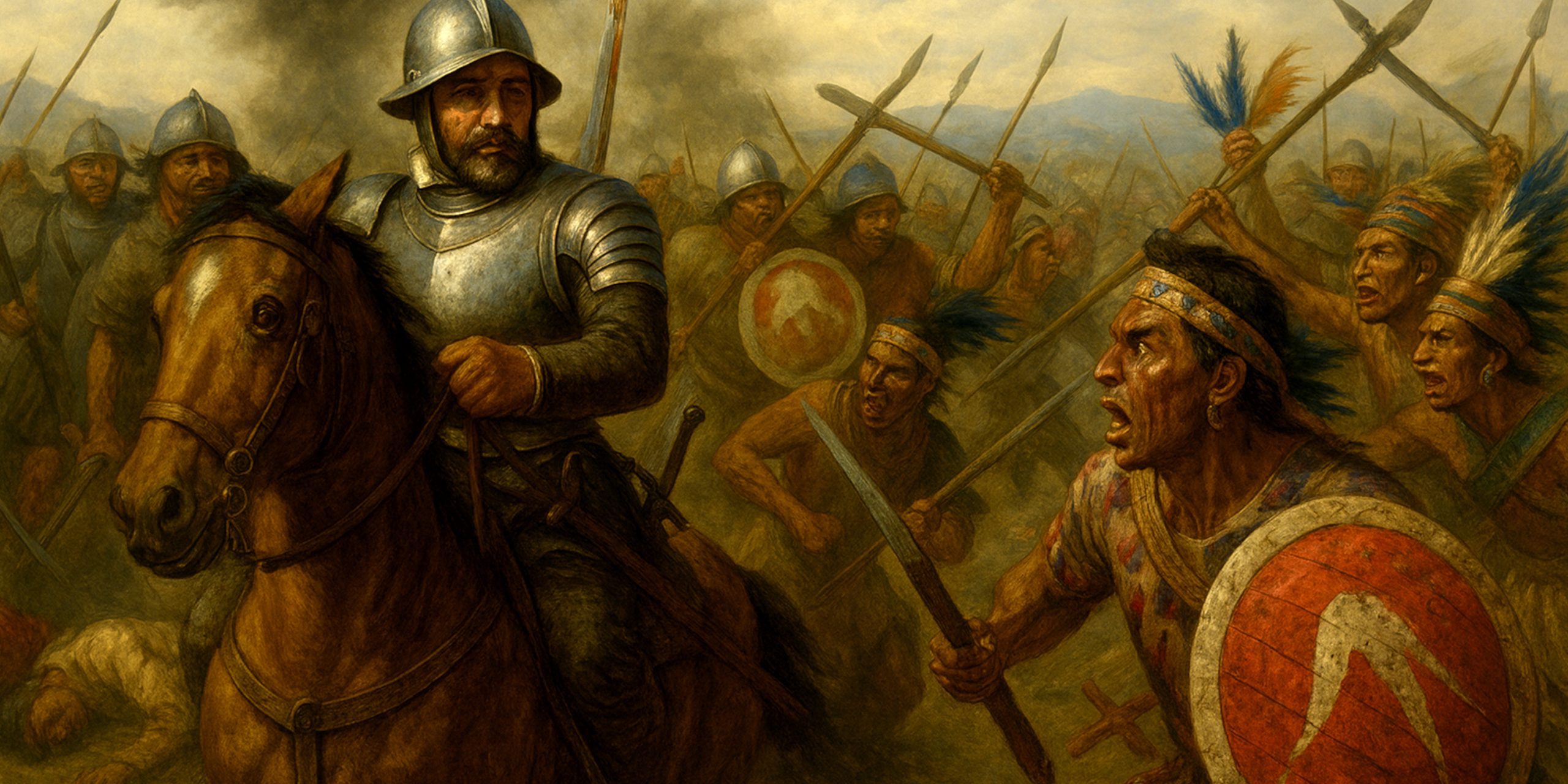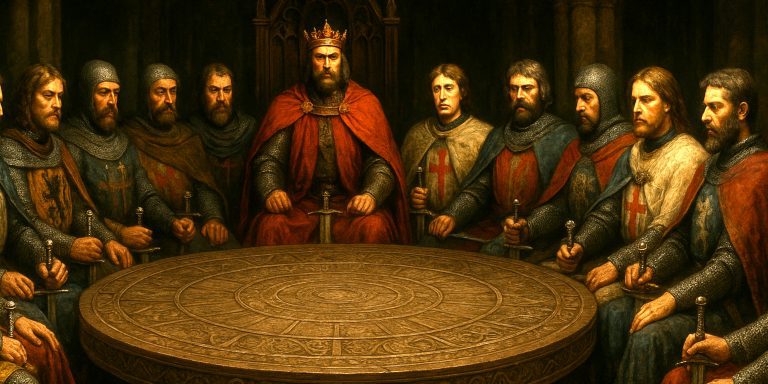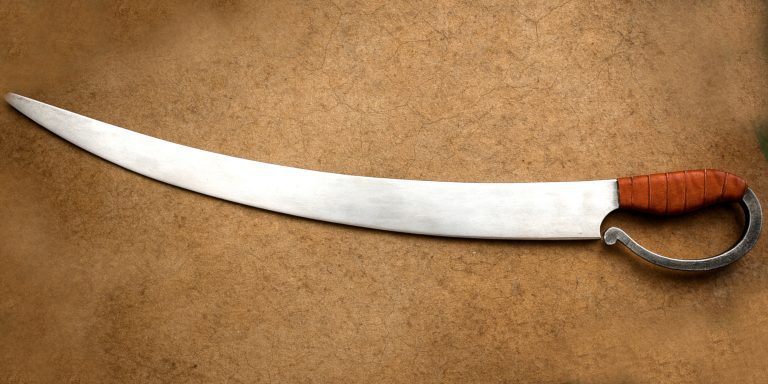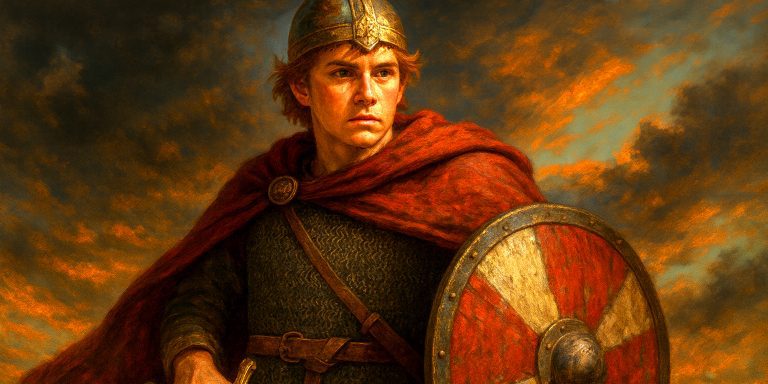
The Conquest of Tlaxcala in 1519 was not a straightforward military engagement but a brutal series of clashes that set the stage for the downfall of the Aztec Empire. Hernán Cortés and his small Spanish force, newly landed in Mexico, marched inland expecting either submission or diplomacy. What they found instead was a fiercely independent confederation of warriors who despised the Aztecs almost as much as they despised invaders. The ensuing campaign was a paradox of slaughter and alliance, a grim handshake forged in blood.
Background
Before the Spaniards arrived, Tlaxcala stood as a confederation of four republics in the shadow of the Aztec Triple Alliance. For years, they resisted Aztec domination, trading in defiance rather than tribute. When Cortés arrived seeking allies against Tenochtitlan, he met instead with a storm of Tlaxcalan obsidian-tipped spears.
The early skirmishes were vicious. The Spanish cavalry terrified the Tlaxcalans at first, but their numerical strength and terrain knowledge made them formidable. It took diplomacy, captured emissaries, and a healthy dose of exhaustion on both sides for peace to prevail. Ironically, the Tlaxcalans would soon march beside Cortés to destroy the Aztec capital itself.
Forces
| Side | Leaders | Estimated Strength | Composition |
|---|---|---|---|
| Spanish Expedition | Hernán Cortés, Pedro de Alvarado, Cristóbal de Olid | ~400 Spaniards | Infantry with steel swords, pikes, crossbows, arquebuses, and cavalry |
| Tlaxcalan Confederation | Xicoténcatl the Younger, Maxixcatzin, Xicoténcatl the Elder | 20,000–40,000 warriors (approx.) | Infantry armed with obsidian-edged macuahuitl, spears, bows, and shields made from wood and leather |
The numbers tell the story: Cortés was outnumbered nearly a hundred to one. Yet the combination of superior steel, cavalry shock tactics, and gunpowder ensured that the Spaniards could wound morale as effectively as flesh.
Arms and Armour
Spanish Weaponry and Protection
- Swords: Steel espadas roperas and cut-and-thrust swords, often Toledo-forged, capable of slicing through native armour with brutal efficiency.
- Lances and Pikes: Used to break Tlaxcalan charges.
- Arquebuses and Crossbows: Primitive but psychologically devastating. The first gunfire Tlaxcalans ever heard was mistaken for thunder.
- Armour: Steel cuirasses and helmets, though many wore quilted cotton for mobility in the heat.
- Horses: The Spaniards’ most fearsome advantage. Tlaxcalans at first believed them to be half-man, half-beast.
Tlaxcalan Weaponry and Armour
- Macuahuitl: A wooden club lined with obsidian blades sharp enough to decapitate a horse.
- Spears and Atlatls: Used to hurl darts with startling precision.
- Bows and Arrows: Effective at range but of little use against steel plate.
- Armour: Quilted cotton vests (ichcahuipilli), feathered headdresses, and painted shields.
- Symbolic Blades: Ornate obsidian ceremonial swords used by nobles, more for prestige than practicality.
It was, quite literally, stone versus steel. The Spanish weapons cut cleaner, but the Tlaxcalan blows landed with terrifying force. Many Spaniards remarked that the obsidian could slice “as fine as glass.”
Course of the Campaign
The conflict unfolded over several weeks between August and September 1519.
- Initial Skirmishes – Cortés’s vanguard clashed with small Tlaxcalan patrols near the borders of their territory.
- Battle of Tecoac Valley – A fierce engagement in which the Tlaxcalans nearly overwhelmed the Spanish, who were forced into a tight defensive formation.
- Night Raids – Tlaxcalans attacked the Spanish camp repeatedly, testing their endurance and discipline.
- Diplomatic Turn – Envoys sent by Xicoténcatl the Elder eventually called for peace, recognising the Spaniards as a potential weapon against their long-time Aztec enemies.
- Alliance Forged – Cortés entered Tlaxcala city as both guest and conqueror. The two sides sealed an alliance that would lead to the sack of Tenochtitlan two years later.
Archaeology
Archaeological digs in the modern state of Tlaxcala have uncovered battlefield artefacts that tell a grim tale of contact and collision.
- Obsidian shards with embedded traces of European metal have been found, evidence of native weapons striking steel.
- Spanish stirrups and spurs discovered near Tlaxcalan fortifications confirm the cavalry’s involvement deep within hostile territory.
- Cotton armour fragments suggest the Tlaxcalans adapted their equipment after the war, possibly incorporating European materials in later campaigns.
Recent excavations near Tecoac even revealed a hybridised sword, a Spanish blade re-hilted in native style, proof that technological exchange followed in the wake of bloodshed.
Battle Timeline
| Date | Event | Outcome |
|---|---|---|
| Aug 1519 | Cortés enters Tlaxcalan territory and is ambushed by patrols. | Initial Spanish casualties, Tlaxcalan confidence high. |
| Late Aug 1519 | Battle of Tecoac Valley. | Heavy losses on both sides; Spanish discipline holds. |
| Early Sept 1519 | Tlaxcalan night attacks. | Spanish gunfire inflicts mass casualties. |
| Mid Sept 1519 | Tlaxcalan council debates peace. | Decision to negotiate with Cortés. |
| Late Sept 1519 | Cortés and Tlaxcalans form alliance. | Tlaxcala joins Spaniards against the Aztecs. |
Contemporary Quotes
“They came at us in waves, their faces painted, their cries like the sea in a storm. Never have I known such courage.”
*– Bernal Díaz del Castillo, The True History of the Conquest of New Spain
“Better to fight beside the enemy of my enemy, than to die by Aztec hands.”
– Attributed to Xicoténcatl the Elder, oral tradition recorded later by friars
“The Tlaxcalans are a people fierce in war, yet honourable in word. Their spears did not bend, nor their pride.”
– Hernán Cortés, Letter to Charles V
Legacy
The alliance between Spain and Tlaxcala would prove decisive in the conquest of Mexico. The Tlaxcalans supplied thousands of warriors for the march on Tenochtitlan, suffering enormous losses but securing autonomy within the Spanish colonial order. For centuries, their descendants proudly claimed the title of “Friends of the Spaniards”, though history has not always been kind to that friendship.
The conquest of Tlaxcala was thus less a battle and more a rehearsal for empire. A small European force learned that native politics could be as potent as any weapon, and an indigenous nation gambled its future on the destruction of its rival. Both won, briefly. Then both were consumed by the empire that rose from their uneasy pact.
The Seven Swords Takeaway
The Conquest of Tlaxcala stands as a testament to the brutal pragmatism of early colonial warfare. Outnumbered Spaniards used terror, steel, and calculated diplomacy to survive, while Tlaxcala turned vengeance into alliance. It is a story of strategy more than slaughter, of how the road to Tenochtitlan was paved not just with bodies, but with hard bargains. One might almost admire it, if it weren’t so soaked in irony and blood.
Watch the documentary:



